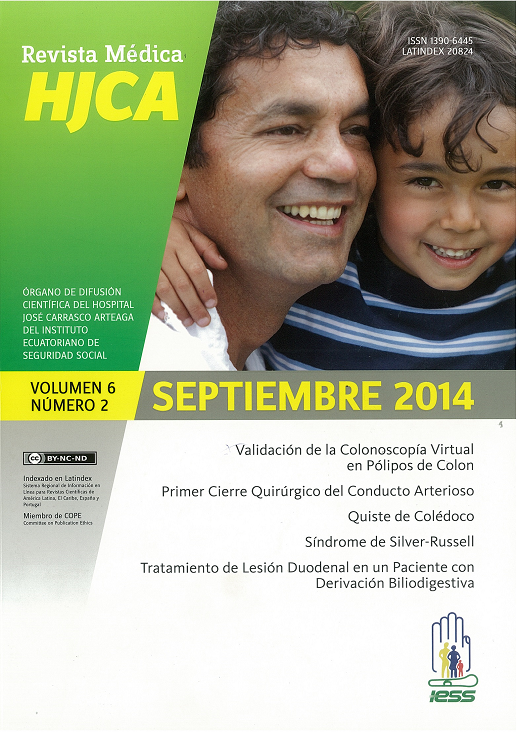Peritonitis Secundaria y Factores Asociados en el Hospital “José Carrasco Arteaga”. Cuenca, Enero a Junio del 2013
Palabras clave:
PERITONITIS, CIRUGÍA, SISTEMA DIGESTIVO, PREVALENCIA, FACTORES DE RIESGO, SURGERY, DIGESTIVE SYSTEM,, PREVALENCE, RISK FACTORSResumen
INTRODUCCIÓN: El objetivo del presente estudio fue identificar y cuantificar la influencia de los distintos factores, hipotéticamente relacionados con aparición de peritonitis secundaria el Hospital “José Carrasco Arteaga” (HJCA) en la ciudad de Cuenca-Ecuador.
MÉTODOS: Este estudio transversal fue llevado a cabo entre 1 de enero del 2013 hasta el 31 de octubre de 2013 en el departamento de cirugía del HJCA. La población de estudio fueron pacientes que ingresaron con patología quirúrgica a nivel abdominal. Se registraron los casos que desarrollaron peritonitis secundaria y las siguientes variables: edad, sexo, procedencia, instrucción, estado nutricional, estado físico según la American Society of Anesthesiologists (ASA), diagnóstico, comorbilidades y tiempo de evolución de la enfermedad.
RESULTADOS: 291 pacientes ingresaron al estudio, con edad de 41.0 ±17.9 años. La prevalencia de peritonitis fue del 8.6% y la principal causa que generó fue las patologías post quirúrgicas con el 28%. Aumentan el riesgo de peritonitis secundaria los siguientes factores: pacientes con valoración ASA III, RP 4.35 (2.2-8.4), con periodos de espera más de 48 horas antes de cirugía RP 6.4 (3.14-13.10) las comorbilidades como la Hipertensión RP 2.87 (1.33-6.06), diabetes RP 2.72 (1.04-7.14) y la inmunosupresión RP 12 (8.2-17.7).
CONCLUSIONES: La peritonitis secundaria en el presente estudio está dentro de la frecuencia de los reporte internaciones cuya prevalencia va del 2 al 14%. La diabetes e hipertensión así como el estado físico ASA III son factores de riesgo para su presentación en este grupo.
ABSTRACT
SECONDARY PERITONITIS AND ASSOCIATED FACTORS IN THE “JOSÉ CARRASCO ARTEAGA” HOSPITAL, CUENCA, JANUARY TO JUNE 2013
BACKGROUND: The aim of this study was to identify and quantify the influence of different factors, hypothetically related to the occurrence of secondary peritonitis at “José Carrasco Arteaga” Hospital (JCAH) in the city of Cuenca, Ecuador.
METHODS: This cross-sectional study was conducted between January 1, 2013 until October 31, 2013 in the Department of Surgery JCAH. The study population consisted of patients admitted with surgical pathology at the abdominal level. The cases recorded developed secondary peritonitis and the following variables were recorded: age, sex, origin, education, nutritional status, physical status according to the American Society of Anesthesiologists (ASA), diagnosis, comorbidities, and duration of the disease.
RESULTS: Two-hundred-ninety-one (291) patients entered the study, aged 17.9 ± 41.0 years. The prevalence of peritonitis was 8.6% and the main cause that generated the post surgical pathology was 28%. The following factors increase the risk of secondary peritonitis: patients with ASA III RP rating 4.35 (2.2- 8.4), with waiting periods of more than 48 hours before surgery RP 6.4 (3.14-13.10) comorbidities such as hypertension RP 2.87 (1.33 -6.06), diabetes RP 2.72 (1.04-7.14) and RP 12 (8.2-17.7) immune-suppression.
CONCLUSIONS: Secondary peritonitis in this study is within the frequency of hospitalizations report whose prevalence ranges from two to 14%. Diabetes and hypertension as well as ASA III physical status are risk factors for presentation in this group.
KEYWORDS:, /,,.

